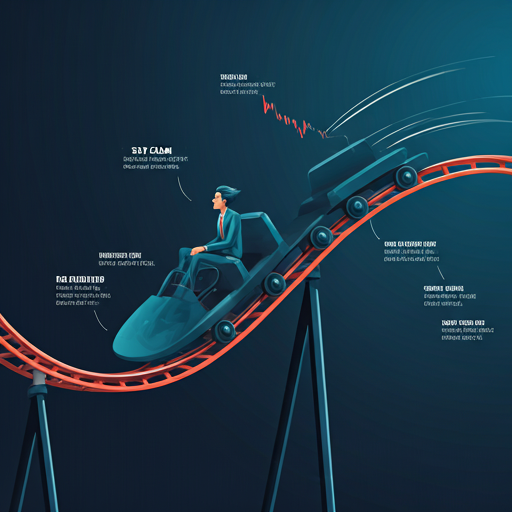Navigating the Stock Market Rollercoaster: Tips for Investors
What Causes Market Fluctuations?
Market fluctuations are primarily driven by supply and demand dynamics. When investors perceive potential gains, demand increases, leading to price surges. Conversely, negative news can trigger panic selling, causing prices to plummet. This volatility reflects market sentiment and economic indicators. Understanding these factors is crucial for informed decision-making. Knowledge is power in investing. Additionally, geopolitical events and central bank policies can significantly impact market stability. Awareness of these influences is essential for strategic planning.
The Impact of Economic Indicators
Economic indicators play a crucial role in shaping market expectations. Key indicators include:
These metrics provide insights into economic health. Investors often react to changes in these indicators. Awareness is vital for strategic decisions. For instance, rising unemployment may signal economic downturns. This can lead to market sell-offs. Understanding these trends is essential for effective investing. Knowledge is a valuable asset.
Investment Strategies for Uncertain Times
Diversification: Spreading Your Risk
Diversification is a fundamental strategy for managing investment risk. By spreading investments across various asset classes, investors can mitigate potential losses. This approach reduces the impact of poor performance in any single investment. A balanced portfolio is essential for stability. For example, combining stocks, bonds, and real estate can enhance returns. Each asset class behaves differently under market conditions. Understanding this can lead to better outcomes. Knowledge is key in investing.
Long-Term vs. Short-Term Investing
Long-term investing typically focuses on capital appreciation over several years. This strategy allows investors to ride out market volatility. He can benefit from compounding returns. In contrast, short-term investing aims for quick gains through frequenr trades. This approach requires constant market monitoring. It can be riskier due to price fluctuations. Understanding both strategies is essential for effective portfolio management. Knowledge empowers informed decisions.
Technical Analysis: Reading the Market
Key Indicators to Watch
Key indicators in technical analysis include moving averages and relative strength index (RSI). Moving averages help identify trends over specific periods. He can use them to smooth out price fluctuations. The RSI measures the speed and change of price movements. It indicates whether an asset is overbought or oversold. Understanding these indicators is crucial for making informed trading decisions. Knowledge is essential for successful investing.
Chart Patterns and Trends
Chart patterns and trends are essential for technical analysis. Common patterns include head and shoulders, triangles, and flags. Each pattern indicates potential market movements. For instance, a head and shoulders pattern often signals a reversal. Recognizing these patterns can enhance trading strategies. He should analyze historical data for better predictions. Patterns provide valuable insights. Understanding them is crucial for success.
Fundamental Analysis: The Bigger Picture
Evaluating Company Performance
Evaluating company performance involves analyzing financial statements and key metrics. Important metrics include earnings per share (EPS) and return on equity (ROE). These figures provide insights into profitability and efficiency. He should also consider revenue growth and securities industry share. Understanding these factors helps assess a company’s competitive position. Knowledge is essential for informed decisions. A thorough analysis leads to better investment choices.
Understanding Market Sentiment
Understanding market sentiment is crucial for effective investing. It reflects the overall attitude of investors toward a particular security or market. He can gauge sentiment through indicators like the Fear and Greed Index. These indicators provide insights into potential market movements. Additionally, news and social media can significantly influence sentiment. Awareness of these factors is essential for strategic decision-making. Knowledge is power in the financial landscape.
Risk Management Techniques
Setting Stop-Loss Orders
Setting stop-loss orders is a vital risk management technique. These orders automatically sell a security when it reaches a specified price. He can limit potential losses by using them effectively. Additionally, determining the appropriate stop-loss level is crucial. Factors to consider include volatility and personal risk tolerance. This strategy helps maintain discipline in trading. Knowledge of stop-loss orders is essential for success.
Position Sizing Strategies
Position sizing strategies are essential for effective risk management. He should determine the appropriate amount to invest based on account size and risk tolerance. Common methods include fixed dollar amount and percentage of equity. These strategies help mitigate potential losses. Additionally, adjusting position sizes according to market conditions is crucial. Flexibility is key in trading. Understanding position sizing enhances overall trading performance.
The Role of Emotions in Investing
Recognizing Emotional Triggers
Recognizing emotional triggers is vital for successful investing. Emotions like fear and greed can cloud judgment. He must identify situations that provoke these feelings. Common triggers include market volatility and news events. Understanding these triggers helps maintain discipline. A clear strategy can mitigate emotional responses. Awareness is crucial for informed decision-making. Knowledge leads to better investment outcomes.
Strategies to Maintain Discipline
Strategies to maintain discipline are essential for successful investing. Establishing a clear trading plan helps mitigate emotional decisions. He should set specific entry and exit points. Regularly reviewing performance can reinforce adherence to the plan. Additionally, utilizing automated trading tools can reduce emotional interference. Consistency is key in trading. A disciplined approach leads to better outcomes.
Leveraging Technology in Investing
Using Trading Platforms and Tools
Using trading platforms and tools enhances investment efficiency. These platforms provide real-time rata and analytics. He can access various financial instruments easily. Additionally, many platforms offer customizable features for personalized trading experiences. Utilizing charting tools can improve technical analysis. This leads to more informed decision-making. Technology is a powerful ally in investing. Understanding these tools is essential for success.
The Rise of Algorithmic Trading
The rise of algorithmic trading has transformed financial markets. Algorithms execute trades based on predefined criteria, enhancing speed and efficiency. He can capitalize on market opportunities instantly. Additionally, these systems analyze vast amounts of data quickly. This leads to more informed trading decisions. Understanding algorithmic strategies is crucial for modern investors. Knowledge of technology is essential for success.
